|
Click pictures for a larger version.

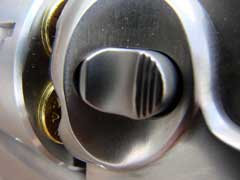
Cylinder release latch.



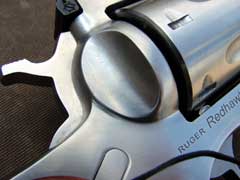
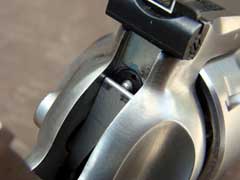
Transfer bar safety prevents firing unless the trigger
is held back.
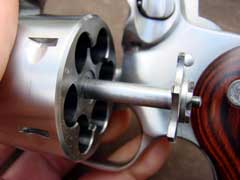
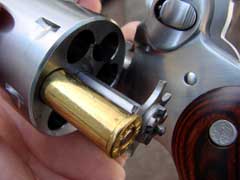
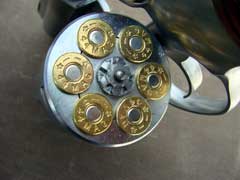
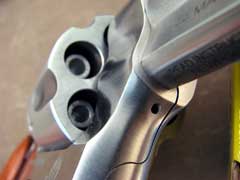
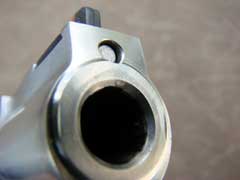
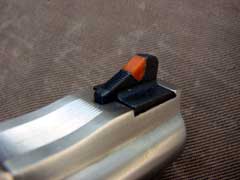


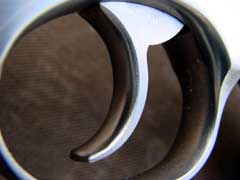
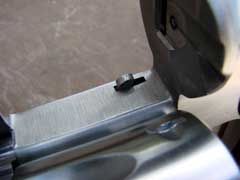



|
|
Ruger introduced
their innovative Redhawk revolver
thirty-five years ago. At the time, the Security-Six and its kin
were the only double-action revolvers in Ruger's lineup, and
fine sixguns they were. However, Ruger was not satisfied to just
build a larger version of the 357 Magnum Security-Six to accept
the 44 Magnum cartridge. Instead, while resembling the Six
series revolvers on the outside, the Redhawk had an innovative
lockwork that used a single spring system to power both the
trigger and hammer. The bolt notches in the cylinder are offset
from center, and the large diameter of the cylinder, as well as
its length, enable the big Redhawk to handle any 44 Magnum load
on the market. The cylinder locks into the frame by a pin at the
rear and a pivoting blade at the front of the crane. Having no
sideplate on the frame, the Redhawk was the strongest 44 Magnum
double-action revolver on the market in 1979, and is only
challenged by Ruger's own Super
Redhawk today. The Redhawk has been chambered at various
times for the 357, 41, and 44 Magnum cartridges, as well as for
the 45 Colt cartridge.
The 44 Magnum Redhawk shown here is a special
version made exclusively for the TALO group. TALO is an
association of several firearms distributors, giving the group
the buying power needed to have special versions of firearms
built solely for distribution by the individual distributors in
the association.
The Redhawk is offered by Ruger through any
distributor with a 4.2, 5.5, or a 7.5 inch barrel, but this TALO
exclusive wears a nominal 2.75 inch barrel. Also differentiating
this TALO sixgun from the standard Redhawk is that this
short-barreled version has a round butt grip, instead of the
usual squared version, making this special edition easier to
carry comfortably, and easier to conceal.
The
detailed specifications of the Redhawk are listed in the chart
below. All linear measurements are listed in inches, and the
weight is listed in ounces. The trigger pulls are listed in
pounds of resistance. SA is the single-action trigger pull. DA
is the double-action trigger pull. Height includes the sights,
set to the intermediate elevation position.
| Weight |
43.2 ounces |
| Barrel Length |
2.67 inches |
| Trigger Pull SA |
6.6 pounds |
| Trigger Pull DA |
8.9 pounds |
| Cylinder Length |
1.76 inches |
| Cylinder Diameter |
1.78 inches |
| Chambers |
6 |
| Overall Length |
7.92 inches |
| Overall Height |
5.78 inches |
| Barrel / Cylinder Gap |
0.006 inch |
| Ammunition |
44 Magnum / 44 Special |
| MSRP as of August 2014 |
$999 US |
I
fired the Redhawk for function using a variety of 44 Magnum and
44 Special ammunition. Velocity testing was done at a distance
of ten feet from the muzzle. Velocities were recorded at an
elevation of 541 feet above sea level, and are listed in
feet-per-second (fps). Velocity testing was done at a
temperature of eighty-eight degrees Fahrenheit, with a relative
humidity of thirty-four percent. I also tested the Redhawk for
accuracy at a distance of twenty-five yards, with the weapon
secured into my Ransom Master Series
machine rest, until I managed to break the finger on my
Ransom. That machine has seen a lot of use in the past eight
years, and I was bound to break a part sometime. I had to finish
accuracy testing with the weapon hand-held over my Target
Shooting, Inc. Handgun Rest. JHP is a jacketed hollowpoint
bullet. TAC-XP is a homogenous copper hollow point bullet. LFN
is a cast lead flatnose bullet. JFN is a jacketed flatnose
bullet. LHP is a lead hollowpoint bullet. Bullet weights are
listed in grains. In addition to the accuracy testing done from
the machine rest, Al Anderson (The Swede) and I tested the
sixgun hand-held over sandbags at a distance of twenty-five
yards using The Swede's handloads. This Redhawk performed very
well using those handloaded cast lead bullets while we were
shooting the revolver in the Upper Peninsula (U.P.) of Michigan
last month.
44
Magnum
| Ammunition |
Bullet Weight |
Velocity |
| Buffalo Bore TAC-XP |
200 |
1401 |
| Buffalo Bore JHP |
180 |
1312 |
| Buffalo Bore JFN |
300 |
1183 |
| Buffalo Bore Low Recoil |
255 |
1198 |
| Bruin LFN |
295 |
1156 |
| Cor-Bon JHP |
165 |
1251 |
| Cor-Bon LFN |
320 |
1143 |
44
Special
| Ammunition |
Bullet Weight |
Velocity |
| Buffalo Bore LHP |
190 |
1000 |
| Buffalo Bore Keith |
255 |
883 |
| Federal LHP |
200 |
798 |
| Speer JHP |
200 |
686 |
| Buffalo Bore TAC-XP |
200 |
1028 |
| Double Tap JHP |
200 |
782 |
| Cor-Bon JHP |
165 |
950 |
The snubby Redhawk performed very well.
Accuracy was excellent, and velocities were pretty close to
those of a four and
one-quarter-inch barreled revolver that I fired just recently,
in spite of the Ruger's six one-thousandths inch (.006)
barrel/cylinder gap. Every type of ammunition fired worked very
reliably. The only issue was that with the Cor-Bon 320 grain
loads, extraction was very sticky. Everything else ejected
smoothly and easily. The revolver handled very well, and the
smooth trigger pull contributed greatly to its excellent
accuracy when fired hand-held, both standing and from the bench.
The Redhawk would group five shots into groups as small as one
and one-quarter inches at twenty-five yards to as large as three
and one-half inches, depending upon the ammunition. In the U.P.
last month, I fired at steel at a distance of fifty yards,
grouping many shots into a three inch cluster, firing off of
sandbags. The Swede did every bit as well, and we made many hits
on steel at a distance of one hundred yards, and beyond. Many
shooters think that a short barrel is not accurate. That is
false. A short barrel can be every bit as accurate as a longer
barrel. It is just easier for most shooters to use the potential
accuracy of a longer barrel, as the distance between the
sights is greater. A short-barreled revolved takes a bit more
concentration to make hits at long distances, but it is very
possible, with a bit of practice.
The Redhawk shown here has a rounded butt, so
other Redhawk grips will not fit this version. With the heaviest
loads, recoil can be pretty stiff, and the Redhawk grip does not
have a padded backstrap, so the recoil of the steel backstrap
hitting between the thumb and trigger finger can be punishing
after a while. With normal loads or just a few of the heavier
ones, this is not problem, but recoil is cumulative, so when
firing a quantity of ammunition at one session, I like to wear a
shooting glove with this compact revolver. For hunting, or for
carrying as protection from man or beast, no glove is needed. If
a lot of heavy loads are anticipated to be fired in one session,
the grip on the Super Redhawk Alaskan is a better choice, but
the two will not interchange.
The Ruger Redhawk shown here has a suggested
retail price of $999 US as of the date of this review. Like all
Ruger firearms, the Redhawk is built in the USA.
Check out the extensive line of Ruger
firearms and accessories online at www.ruger.com.
For the location of a Ruger dealer near you,
click on the DEALER FINDER at www.lipseys.com.
To order the Redhawk online, click on the GUN
GENIE at www.galleryofguns.com.
To order quality ammunition, go to www.buffalobore.com,
www.doubletapammo.com,
www.luckygunner.com,
and www.midsouthshooterssupply.com.
Check
out the Bob Mernickle holster at www.mernickleholsters.com.
Jeff Quinn
  
Got something to say about this article?
Want to agree (or disagree) with it? Click the following link to
go to the GUNBlast Feedback Page.
|
|
Click pictures for a larger version.
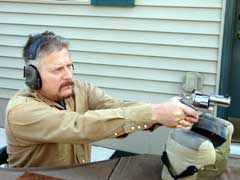

"The Swede" Al Anderson shooting the Redhawk
on steel targets at 100 yards.
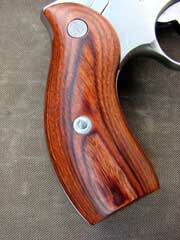
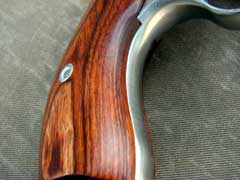
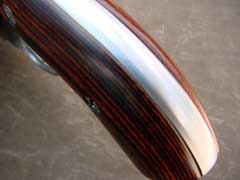
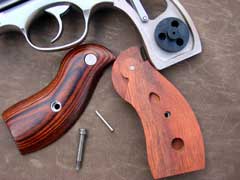
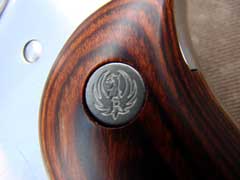
Laminated wood grips.
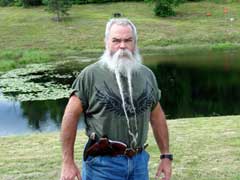
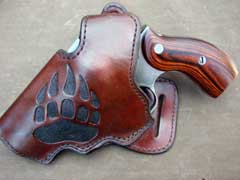
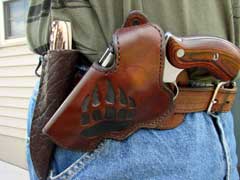


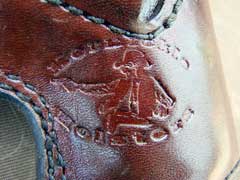
Mernickle crossdraw holster.

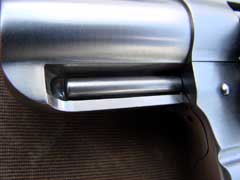


Cylinder has plenty of length to accept even long
320-grain loads.
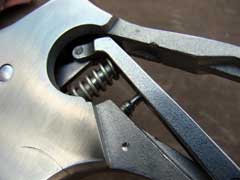
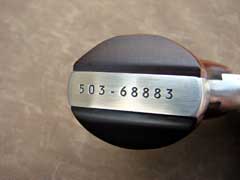
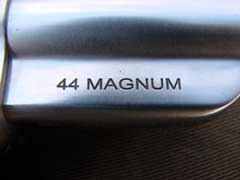
|
![]()